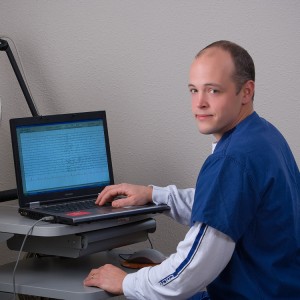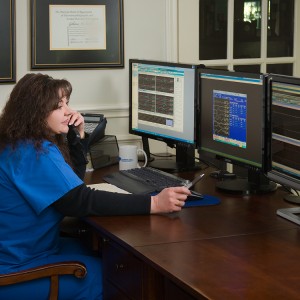Information on intraoperative monitoring services:
 Intraoperative testing and monitoring is a medical service ordered by a surgeon when the brain and/or spinal cord are at risk during a surgical procedure. Data is collected and reported to the surgeon to prevent permanent damage. During spinal cord surgeries instrumentation is placed to stabilize the spinal cord. Due to the degree of spinal manipulation and placement of instrumentation near the spinal cord and nerve roots, the patient is at risk for spinal cord injury and potential paralysis. The testing allows for decisions to be made about placement of the instrumentation before permanent spinal cord damage occurs.
Intraoperative testing and monitoring is a medical service ordered by a surgeon when the brain and/or spinal cord are at risk during a surgical procedure. Data is collected and reported to the surgeon to prevent permanent damage. During spinal cord surgeries instrumentation is placed to stabilize the spinal cord. Due to the degree of spinal manipulation and placement of instrumentation near the spinal cord and nerve roots, the patient is at risk for spinal cord injury and potential paralysis. The testing allows for decisions to be made about placement of the instrumentation before permanent spinal cord damage occurs.
During brain surgeries, brain tissue is retracted or held out of the way to reach deeper structures during surgery. We test several areas of the brain, the brainstem and cranial nerves to insure that no damage occurs to those tissues retracted or those being operated on. In the case of a brain tumor removal, it is difficult for the surgeon to tell at times which is healthy brain tissue and which is tumor. We can help. There are also times in which the position and shape of the brain is distorted from a tumor and the surgeon wants to avoid important areas of the brain responsible for motor function. Again we can perform tests to help guide him in making better decisions. In neurovascular surgery such as cerebral aneurysms the surgeon may be unsure of the importance of a specific vessel. He can temporarily clip the vessel and we can tell him if ischemic damage will occur if that vessel is permanently clipped.
We travel to hospitals to perform such testing as listed above and more. Our job is to assist the surgeon through various types of testing to avoid unforeseen damage to the brain or spinal cord which would result in debilitating injury or even death during these high risk surgeries
How the process works:
First of all we must have a written order and request from the operating surgeon to perform the service. It is the surgeon who decides what structures are at risk and what specific type of testing is performed. We then arrive at the hospital with the necessary equipment and apply the electrodes to perform the testing. Baseline recordings are performed before any procedure takes place to see how the brain and spinal cord function are prior to surgery. A supervising physician is either on site or available live via computer modem to interpret the data at the time the testing is performed. The testing is performed until the risk is over. Final samples are recorded after the case to indicate that no changes occurred during the procedure indicating no damage to the patient. If changes do occur, these changes are documented and appropriate actions taken.
 The reason why facilities do not offer this service is because they do not have the staff available to perform the testing. This type of testing requires a highly skilled and boarded technologist and expensive equipment. To date there are a limited number of technologists in the entire country leaving many hospitals with no alternative than allow outside companies such as ours to provide the services. Often times a facility may not have enough cases requiring this type of testing to justify hiring a technologist or purchasing a piece of equipment needed to provide the service. At one of our facilities, a job position for such a technologist has been open and unfilled for over 10 years.
The reason why facilities do not offer this service is because they do not have the staff available to perform the testing. This type of testing requires a highly skilled and boarded technologist and expensive equipment. To date there are a limited number of technologists in the entire country leaving many hospitals with no alternative than allow outside companies such as ours to provide the services. Often times a facility may not have enough cases requiring this type of testing to justify hiring a technologist or purchasing a piece of equipment needed to provide the service. At one of our facilities, a job position for such a technologist has been open and unfilled for over 10 years.
We are fully staffed with highly trained technologists who are all boarded by the American Board of Registration of Electroencephalographic and Evoked Potential Technologists (ABRET). All technologists are boarded in Neurodiagnostics and/or the Certification of Neurophysiologic Intraoperative Monitoring (CNIM). We been inspected and approved by Medicare as an Independent Diagnostic Testing Facility.
